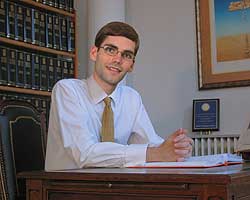The Department of Electrical Engineering and Computer Science at MIT welcomed its newest faculty member, Tomás Palacios, in September 2006. Palacios is also set to conduct research at the Institute's Microsystems Technology Laboratories (MTL).
 "I am thrilled to join the Microsystems Technology Laboratories at MIT," Palacios said. "I believe that electronics is going to be redefined in the near future - it's going to be all about the integration of heterogeneous properties and materials to fabricate new devices with novel or improved functionalities. At MTL, I have found outstanding faculty, students and staff with tremendous expertise. I think MTL is an extraordinary position from which to help the field of electrical engineering prepare for the exciting new challenges ahead."
"I am thrilled to join the Microsystems Technology Laboratories at MIT," Palacios said. "I believe that electronics is going to be redefined in the near future - it's going to be all about the integration of heterogeneous properties and materials to fabricate new devices with novel or improved functionalities. At MTL, I have found outstanding faculty, students and staff with tremendous expertise. I think MTL is an extraordinary position from which to help the field of electrical engineering prepare for the exciting new challenges ahead."
As an MTL faculty member, Palacios brings experience in wide bandgap semiconductors and new devices, and hopes to find new solutions for high-frequency electronics and the interaction of electronics and biological systems. According to Palacios, the answers to these challenges have the potential to change the world "and I am sure MTL is going to play a very important role in their solution."
MTL's Director, Anantha Chandrakasan, stated, "We are very excited to have Tomá s join MTL. His research on compound semiconductors impacts a number of important areas such photonics, wireless communications, biosensors, high-speed digital logic and energy. The inter-disciplinary nature of his research will enable exciting new collaborations with many research groups at MIT."
Palacios completed his undergraduate work at the Polytechnic University of Madrid in 2001, where he specialized in telecommunication engineering. He received his MS and PhD in 2004 and 2006, respectively, from the University of California Santa Barbara. Palacios has been working in semiconductor materials and devices since 1997, and is the recipient of several awards, including the UCSB Lancaster Award, the 6th International Conference on Nitride Semiconductors Young Researcher Award, the 63rd Device Research Conference Best Student Paper Award, and the European Prize Salva i Campillo (for "most promising European newcomer to engineering").